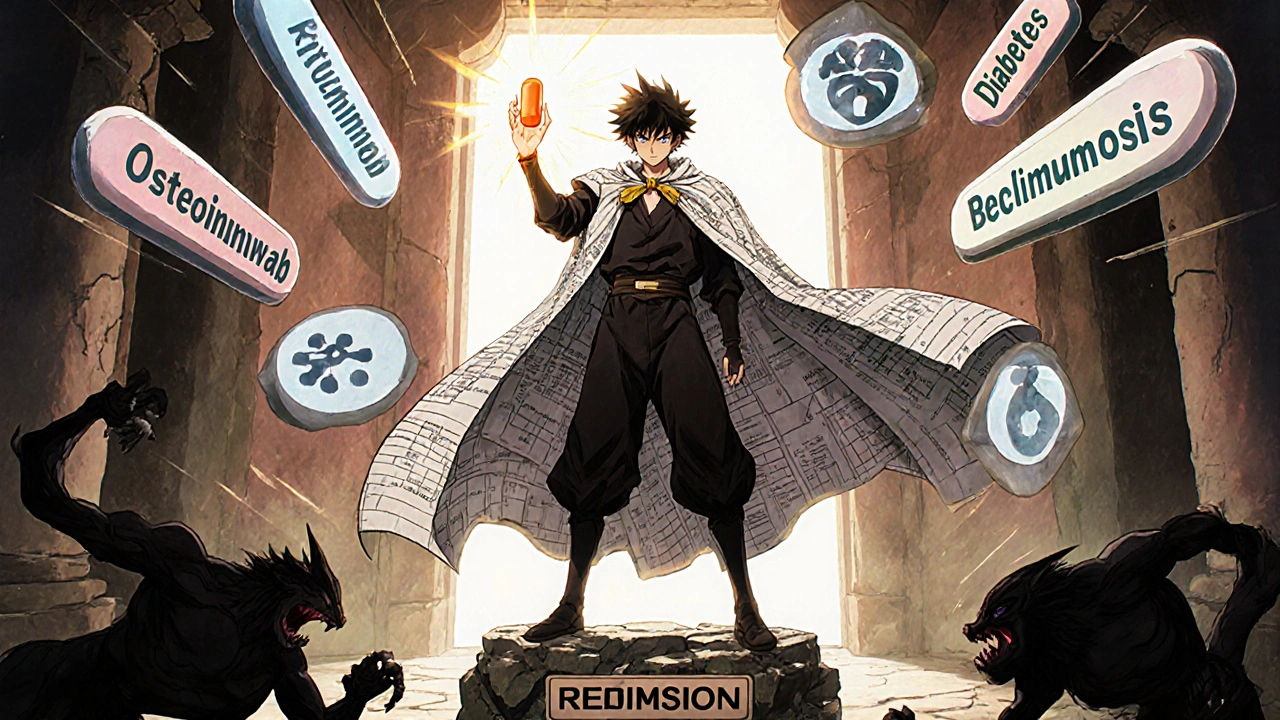What Corticosteroids Do in Autoimmune Diseases
Corticosteroids, like prednisone and methylprednisolone, are synthetic versions of cortisol - the body’s natural stress hormone. They don’t cure autoimmune diseases, but they stop the immune system from attacking healthy tissues. In conditions like rheumatoid arthritis, lupus, and vasculitis, the immune system goes rogue. Corticosteroids quiet that overreaction fast. Within hours, swelling drops. Within days, joint pain eases. That speed is why doctors reach for them first.
They work by slipping into cells and flipping genetic switches. This shuts down the production of inflammatory chemicals like TNF-alpha, interleukins, and enzymes that cause tissue damage. Unlike methotrexate or azathioprine, which take weeks to kick in, corticosteroids act like an emergency brake. For someone with sudden kidney damage from lupus or a flare of Crohn’s disease, that speed saves organs and sometimes lives.
When Corticosteroids Work Best
These drugs are most effective in diseases where inflammation is the main driver. They’re standard for:
- Systemic lupus erythematosus (SLE)
- Rheumatoid arthritis (RA)
- Inflammatory bowel disease (IBD) - especially during flares
- Granulomatosis with polyangiitis (formerly Wegener’s)
- Autoimmune hemolytic anemia
- Severe asthma and allergic reactions
But they don’t help everyone. For advanced type 1 diabetes, Hashimoto’s thyroiditis, Graves’ disease, or late-stage primary biliary cholangitis, corticosteroids do little. Why? Because the damage is already done. The body’s own cells are gone. No amount of anti-inflammatory power can bring them back. In early stages - like newly diagnosed type 1 diabetes with some insulin-producing cells still alive - they might slow the decline. But once the pancreas is mostly destroyed, steroids won’t help.
How Doctors Use Them - Dosing and Duration
Dosing isn’t one-size-fits-all. For mild arthritis, a patient might start at 5-10 mg of prednisone daily. For a severe lupus flare with kidney involvement, doses can hit 60 mg or more - sometimes even with high-dose IV methylprednisolone pulses. The goal is always the same: use the lowest dose that controls symptoms.
Doctors aim for short bursts. A 5- to 10-day course for a sudden asthma attack. A 3-month taper for a skin rash from dermatomyositis. But some patients need longer treatment. In those cases, the plan changes. Instead of staying on high doses, doctors add other drugs - like methotrexate, azathioprine, or rituximab - to reduce steroid dependence. The idea? Let the slower-acting drugs take over while the steroids are slowly weaned off.
Timing matters too. Taking steroids in the morning mimics the body’s natural cortisol rhythm. Taking them at night increases the risk of adrenal suppression - where your body forgets how to make its own cortisol. That’s why doctors always ask when you take your dose.

The Hidden Cost: Long-Term Side Effects
There’s no free lunch. The same power that stops inflammation also breaks down your body over time. After 3 months of daily use, risks climb fast.
- Bone loss: Corticosteroids block bone-building cells and increase calcium loss. Up to 40% of long-term users develop osteoporosis. Many break a bone before they even know they had weak bones.
- Cataracts and glaucoma: Cloudy lenses and increased eye pressure are common after a year or more of use. Regular eye checks are non-negotiable.
- Weight gain and moon face: Fat shifts to the belly, face, and back. Fluid retention makes you swell. This isn’t just cosmetic - it raises blood pressure and diabetes risk.
- Diabetes: Steroids make the liver pump out more glucose and block insulin. New-onset diabetes is common in people on long-term therapy.
- Adrenal insufficiency: If you’ve been on more than 10 mg of prednisone daily for over 3 weeks, your adrenal glands shut down. Stop the drug too fast, and you can go into crisis - low blood pressure, vomiting, even death.
- Skin thinning and easy bruising: Even minor bumps leave marks. Wounds heal slower. Some patients develop stretch marks that don’t fade.
These aren’t rare side effects. They’re expected. That’s why every patient on long-term steroids gets bone density scans, eye exams, blood sugar checks, and a clear plan to taper off.
How to Protect Yourself on Long-Term Therapy
If you’re on corticosteroids for more than 3 months, you need a protection plan. It’s not optional.
- Take calcium and vitamin D: At least 1,200 mg of calcium and 800-1,000 IU of vitamin D daily. Some doctors add bisphosphonates like alendronate to prevent fractures.
- Exercise: Weight-bearing activity - walking, lifting, yoga - helps keep bones strong. Don’t wait until you’re weak to start.
- Monitor blood pressure and sugar: Check both monthly at first. High readings mean you need to adjust your diet or add medication.
- Never stop cold turkey: If you’ve been on steroids for more than 3 weeks, tapering must be done slowly - often over weeks or months. Your doctor will guide this.
- Wear a medical alert bracelet: In an emergency, doctors need to know you’re on steroids. If you’re in a car crash or get sick, your body can’t make cortisol on its own. You might need an emergency injection.
- Use sunscreen: Steroids make your skin more sensitive to UV light. Sunburns happen faster. Skin cancer risk goes up.
Alternatives and New Strategies
The goal now isn’t just to use steroids - it’s to use them less. Newer drugs are changing the game.
Rituximab, an antibody that targets B cells, has shown better results than steroids alone in autoimmune hemolytic anemia and some forms of vasculitis. It doesn’t work as fast, but it lasts longer and has fewer long-term risks. Azathioprine and mycophenolate are often added early to let doctors cut steroid doses by half within 3 months.
Biologics like belimumab (for lupus) and tocilizumab (for RA) are replacing steroids in some cases. They’re expensive, but they don’t cause bone loss or diabetes. Clinical trials show patients on these drugs stay in remission longer with fewer side effects.
Topical steroids - creams, inhalers, nasal sprays - are another win. For asthma, eczema, or allergic rhinitis, local delivery means the drug hits the problem area without flooding your whole body. Side effects drop dramatically.

When Steroids Are the Only Option
Some patients have no choice. If you have a rare autoimmune disease with no approved biologics - like certain types of vasculitis or autoimmune encephalitis - steroids may be your only tool. In those cases, the focus shifts to managing side effects aggressively.
Doctors now use a target-based approach: aim for reduced protein in urine, improved lung function, lower muscle enzyme levels. Once those targets are met, they start lowering the dose. The idea isn’t to feel okay - it’s to get your disease under control so you can get off steroids as soon as possible.
What Patients Should Ask Their Doctor
If you’re prescribed corticosteroids, ask these five questions:
- What’s the goal? Is this to get me into remission, or just to control symptoms?
- How long will I be on this? Is there a clear tapering plan?
- What other drugs will I take to reduce my steroid dose?
- What tests will I need - bone scans, eye exams, blood sugar checks?
- What should I do if I miss a dose or feel sick?
Don’t assume your doctor knows you’re scared. Tell them. Say: ‘I’ve heard about the side effects. I want to stay on this as short as possible.’ Most will appreciate the honesty and adjust the plan.
Final Reality Check
Corticosteroids are powerful. They’ve saved millions of lives since the 1950s. But they’re not gentle. They’re a tool - not a cure. Used wisely, they give you breathing room. Used carelessly, they steal your bones, your vision, your energy.
The best outcome isn’t just symptom control. It’s getting off them safely. That’s why modern treatment isn’t about how much you take - it’s about how fast you can stop. If your doctor isn’t talking about a plan to reduce your dose, ask why. Your future self will thank you.


